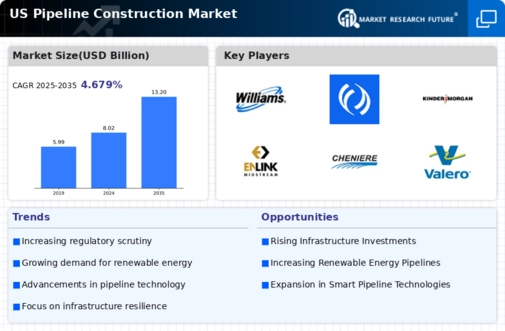The US Pipeline Construction Market is characterized by a competitive landscape that is influenced by a variety of factors including regulatory policies, technological advancements, and the constant demand for energy infrastructure. The market is primarily driven by the need to transport oil, natural gas, and other fluids across the country, necessitating the construction and maintenance of extensive pipeline networks. As companies navigate this dynamic environment, they must focus on innovation, efficiency, and compliance with environmental regulations while also fostering relationships with government and local communities.
The competitive insights derived from this market indicate that industry players must develop strategic partnerships and invest in new technologies to remain relevant and competitive in a sector that is expected to evolve significantly in the coming years.Williams Companies has established itself as a significant player in the US Pipeline Construction Market, with a strong focus on natural gas infrastructure. The company boasts an extensive network of pipelines and processing facilities that enable the efficient transportation of natural gas to various markets across the United States.
Williams Companies is known for its operational excellence and strong commitment to safety and environmental stewardship, which enhances its reputation in the industry. Furthermore, the company has successfully leveraged its position through strategic expansions and investments, ensuring a robust presence in critical resource-rich regions, thereby further strengthening its market influence and stakeholder trust.TC Energy operates as a formidable force within the US Pipeline Construction Market, primarily focusing on the development and operation of energy infrastructure that includes natural gas and liquids pipelines.
The company is recognized for its large-scale projects, which are pivotal for meeting the growing energy demands within the country. TC Energy excels in providing dependable transportation services and works diligently to enhance the efficiency of its pipeline systems. The company's strengths lie in its substantial experience in managing complex projects, its commitment to safety and sustainability, and a strong financial position that supports continual investment in infrastructure upgrades and expansions.
Through a series of strategic mergers and acquisitions, TC Energy has reinforced its market presence and diversified its service offerings, positioning itself as a key player in addressing the evolving needs of the US energy landscape.





















